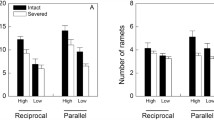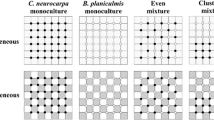Abstract
Physiological integration and foraging behavior have both been proposed as advantages for clonal growth in heterogeneous environments. We tested three predictions concerning their short- and long-term effects on the growth of the clonal perennial sedge Schoenoplectus pungens (Pers.) Volk. ex Schinz and R. Keller: (1) growth would be greatest for clones with connected rhizomes and on heterogeneous soil, (2) clones would preferentially place biomass in the nutrient-rich patches of a spatially heterogeneous environment, and (3) physiological integration would decrease a clone’s ability to forage. We tested our predictions by growing S. pungens clones for 2 years in an experimental garden with two severing treatments (connected and severed rhizomes) crossed with two soil treatments (homogeneous and heterogeneous nutrient distribution). Severing treatments were only carried out in the first year. As predicted, severing significantly decreased total biomass and per capita growth rate in year one and individual ramet biomass both in year one and the year after severing stopped. This reduction in growth was most likely caused by severing damage, because the total biomass and growth rate in severed treatments did not vary with soil heterogeneity. Contrary to our prediction, total biomass and number of ramets were highest on homogeneous soil at the end of year two, regardless of severing treatment, possibly because ramets in heterogeneous treatments were initially planted in a nutrient-poor patch. Finally, as predicted, S. pungens concentrated ramets in the nutrient-rich patches of the heterogeneous soil treatment. This foraging behavior seemed enhanced by physiological integration in the first year, but any possible enhancement disappeared the year after severing stopped. It seems that over time, individual ramets become independent, and parent ramets respond independently to the conditions of their local microsite when producing offspring, a life-history pattern that may be the rule for clonal species with the spreading “guerrilla” growth form.
Similar content being viewed by others
References
P. Alpert (1991) ArticleTitleNitrogen sharing among ramets increases clonal growth in Fragaria chiloensis Ecology 72 69–80
P. Alpert (1999) ArticleTitleEffects of clonal integration on plant plasticity in Fragaria chiloensis Plant Ecol. 141 99–106 Occurrence Handle10.1023/A:1009823015170
P. Alpert H.A. Mooney (1986) ArticleTitleResource sharing among ramets in the clonal herbFragaria chiloensis Oecologia 70 227–233 Occurrence Handle10.1007/BF00379244
J.P. Amon C.A. Thompson Q.J. Carpenter J. Miner (2002) ArticleTitleTemperate zone fens of the glaciated Midwestern USA Wetlands 22 301–317
A. Charpentier F. Mesleard J.D. Thompson (1998) ArticleTitleThe effects of rhizome severing on the clonal growth and clonal architecture of Scirpus maritimus Oikos 83 107–116
H. de Kroon M.J. Hutchings (1995) ArticleTitleMorphological plasticity in clonal plants: the foraging concept reconsidered J. Ecol. 83 143–152
H. de Kroon F. Schieving (1990) Resource partitioning in relation to clonal growth strategy J. van Groenendael H. de Kroon (Eds) Clonal Growth in Plants: Regulation and Function SPB Academic Publishers The Hague 113–130
H. de Kroon J. van Groenendael (Eds) (1997) The Ecology and Evolution of Clonal Plants Bachhuys Publishers Leiden, The Netherlands
T. D’Hertefeldt U. Falkengren-Grerup (2002) ArticleTitleExtensive physiological integration in Carex arenaria Carex disticha in relation to potassium and water availability New Phyotol. 156 469–477
T. D’Hertefeldt I. Jónsdóttir (1999) ArticleTitleExtensive physiological integration in intact clonal systems of Carex arenaria J. Ecol. 87 258–264
M. Dong B. Alaten (1999) ArticleTitleClonal plasticity in response to rhizome severing and heterogeneous resource supply in the rhizomatous grass Psammochloa villosa in an Inner Mongolian duneChina Plant Ecol. 141 53–58 Occurrence Handle10.1023/A:1009875000149
J.P. Evans (1988) ArticleTitleNitrogen translocation in a clonal dune perennial, Hydrocotyle bonariensis Oecologia 77 64–68 Occurrence Handle10.1007/BF00380926
J.P. Evans M.L. Cain (1995) ArticleTitleA spatially explicit test of foraging behavior in a clonal plant Ecology 76 1147–1155
J.P. Evans S. Whitney (1992) ArticleTitleClonal integration across a salt gradient by a nonhalophyteHydrocotyle bonariensis (Apiaceae) Am. J. Bot. 79 1344–1347
C. Hershock (2002) Plant community structure in calcareous fens: effects of competition, soil environmentand clonal architecture University of Michigan Ann Arbor, MI
M.J. Hutchings H. de Kroon (1994) Foraging in plants: The role of morphological plasticity in resource acquisition M. Begon A.H. Fitter (Eds) Advances in Ecological Research v. 25 Academic Press New York 159–238
M.J. Hutchings M. Mogie (1990) The spatial structure of clonal plants: control and consequences J. van Groenendael H. de Kroon (Eds) Clonal Growth in Plants: Regulation and Function SPB Academic Publishers The Hague 57–76
M.J. Hutchings E.A.C. Price (1993) ArticleTitleDoes physiological integration enable clonal herbs to integrate the effects of environmental heterogeneity? Plant Species Biol. 8 95–105 Occurrence Handle10.1111/j.1442-1984.1993.tb00061.x
L. Jerling (1988) ArticleTitleClone dynamics, population dynamics and vegetation pattern of Glaux maritima on a Baltic sea shore meadow Vegetatio 74 171–185
I.S. Jónsdóttir T.V. Callaghan (1989) ArticleTitleLocalized defoliation stress and the movement of C14-photoassimilates between tillers of C. bigelowii Oikos 54 211–219
I.S. Jónsdóttir M.A. Watson (1997) Extensive physiological integration: an adaptive trait in resource-poor environments H. de Kroon J. van Groenendael (Eds) The Ecology and Evolution of Clonal Plants Backhuys Publishers Leiden 109–136
L. Lovett Doust (1981) ArticleTitlePopulation dynamics and local specialization in a clonal perennial (Ranunuculus repens): I. the dynamics of ramets in contrasting habitats J. Ecol. 69 743–755
D.W. Magee (1981) Freshwater Wetlands: A Guide to Common Indicator Plants of the Northeast University of Massachusetts Press Amherst
J.C. Noble C. Marshall (1983) ArticleTitleThe population biology of plants with clonal growth: the nutrient strategy and modular physiology of Carex arenaria J. Ecol. 71 865–877 Occurrence Handle1:CAS:528:DyaL2cXkvVKrtQ%3D%3D
E.A.C. Price C. Marshall M.J. Hutchings (1992) ArticleTitleStudies of growth in the clonal herb Glechoma hederacea. I. Patterns of physiological integration J. Ecol. 80 25–38
B. Schmid F.A. Bazzaz (1987) ArticleTitleClonal integration and population structure in perennials: effects of severing rhizome connections Ecology 68 2016–2022
A.J. Slade M.J. Hutchings (1987) ArticleTitleClonal integration and plasticity in foraging behaviour in Glechoma hederacea J. Ecol. 75 1023–1036
J.F. Stuefer H.J. During H. de Kroon (1994) ArticleTitleHigh benefits of clonal integration in two stoloniferous species, in response to heterogeneous light environments J. Ecol. 82 511–518
J.F. Stuefer H. De Kroon H.J. During (1996) ArticleTitleExploitation of environmental heterogeneity by spatial division of labour in a clonal plant Functional Ecol. 10 328–334
W.J. Sutherland R.A. Stillman (1988) ArticleTitleThe foraging tactics of plants Oikos 52 239–244
InstitutionalAuthorNameSYSTAT (2000) SYSTAT Version 10 SPSS Inc Chicago
E.G. Voss (1972) Michigan Flora; A Guide to the Identification and Occurrence of the Native and Naturalized Seed Plants of the State Cranbrook Institute of Science Bloomfield Hills, Michigan
T. Wilhalm (1995) ArticleTitleA comparative study of clonal fragmentation in tussock-forming grasses Abstracta Botanica 19 51–60
D.K. Wijesinghe (1994) ArticleTitleTemporal and structural components of ramet independence in the clonal perennial herbPotentilla simplex J. Ecol. 82 13–20
D.K. Wijesinghe S.N. Handel (1994) ArticleTitleAdvantages of clonal growth in heterogeneous habitats: an experiment with Potentilla simplex J. Ecol. 82 495–502
D.K. Wijesinghe M.J. Hutchings (1997) ArticleTitleThe effects of spatial scale of environmental heterogeneity on the growth of a clonal plant: an experimental study with Glechoma hederacea J. Ecol. 85 17–28
D.K. Wijesinghe M.J. Hutchings (1999) ArticleTitleThe effects of environmental heterogeneity on the performance of Glechoma hederacea: the interactions between patch contrast and patch scale J. Ecol. 87 860–872 Occurrence Handle10.1046/j.1365-2745.1999.00395.x
Author information
Authors and Affiliations
Corresponding author
Rights and permissions
About this article
Cite this article
Poor, A., Hershock, C., Rosella, K. et al. Do Physiological Integration and Soil Heterogeneity Influence the Clonal Growth and Foraging of Schoenoplectus pungens?. Plant Ecol 181, 45–56 (2005). https://doi.org/10.1007/s11258-005-2429-y
Received:
Accepted:
Issue Date:
DOI: https://doi.org/10.1007/s11258-005-2429-y




